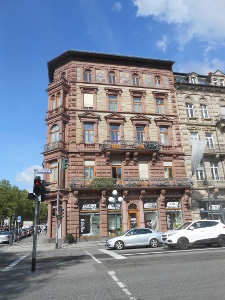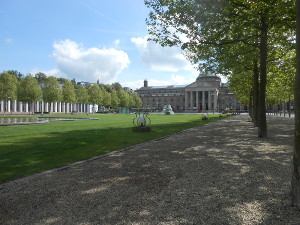 German geese
German geese German geese
German geese
A clear cool day for our day trip to Wiesbaden. All bundled up (with sweater and jacket for Elsa and warm shirt and jacket for Bob) we boarded the S-Bahn in Frankfurt shortly after breakfast, and by 10 we were entering Wiesbaden, where we set off on foot.
We walked past the new Congress Hall being built, and along the edge of a beautiful park complete with fountains and ducks and flowers. The trees are fullly green now.
 Wilhelmstrasse
Wilhelmstrasse
Then we came to the Wilhemstrasse, an elegant shopping street rather like Beverly Hills with fancy clothing stores and well-designed store fronts and facades. Lots of the shops are in the beatiful 19th century buildings along the avenue. We also passed the lovingly restored opera house.
We continued down the street to the Kurhaus, which today is a venue for large events and also the location of an expensive casino. Kurhaus translates roughly to Cure House, where wealthy guests would come to the hot springs spa to take the cure for syphilis or other ailments. This part of Germany has lots of  The Kurhaus
cities with hot springs, all of which have "Bad" (German "bath") as part of their name. We were allowed to see the beautiful central hall but all the other rooms were closed in preparation for a convention. So we kept going out the back door and to another beautiful landscape, with a lake.
The Kurhaus
cities with hot springs, all of which have "Bad" (German "bath") as part of their name. We were allowed to see the beautiful central hall but all the other rooms were closed in preparation for a convention. So we kept going out the back door and to another beautiful landscape, with a lake.
We found the Elizabeth Church, a Lutheran church in the market square, but it wouldn't be open till 2; sorry, because it is unusual in its red brick and tall skinny towers. We photographed the golden statue  Arms of Wiesbaden
of the arms of Wiesbaden.
Arms of Wiesbaden
of the arms of Wiesbaden.
Then over a block to more interesting but less elegant shops, stopping for lunch at a nice Vietnamese restaurant.
At the tourist info office we learned about the Thermine train which does a hop-on, hop-off drive through the city. Much of the trip was winding uphill past the villas of the very wealthy. It's a part of the city we would not otherwise have known about or thought to see. The route of the little train took us  Russian church
near the top of the hill, to visit a Russian Orthodox church hidden in the woods. It was built from1847 to 1855 by a Russian nobleman, Duke Adolf of Nassau on the occasion of the death of his wife, the 19-year-old Grand Duchess Elizabeth Mikhailovna of Russia, niece of Tsar Nicholas, in childbirth. It still serves the local Russian Orthodox community which was quite prosperous and powerful at the time of its construction.
Russian church
near the top of the hill, to visit a Russian Orthodox church hidden in the woods. It was built from1847 to 1855 by a Russian nobleman, Duke Adolf of Nassau on the occasion of the death of his wife, the 19-year-old Grand Duchess Elizabeth Mikhailovna of Russia, niece of Tsar Nicholas, in childbirth. It still serves the local Russian Orthodox community which was quite prosperous and powerful at the time of its construction.  View through trees
The interior is filled with icons and tracts and notices, all in Russian.
View through trees
The interior is filled with icons and tracts and notices, all in Russian.
To return to the Thermine, we had to reach the top of the hill. We continued our walk, huffing and puffing to the top of the hill and the funicular. We stopped at the hilltop snack bar for apple strudel with vanilla sauce, then boarded the sturdy old car which is balanced by its twin to make the trip.
While we waited for our little train to stop for us, we visited the funicular museum, a former public toilet given to that part of the forest by the city of Wiesbaden. It is a very thorough depiction of the life of this little cog railroad.
The little Thermine train carried us the rest of the way back toward the neighborhood of the tourist  Funicular on viaduct
info center where we visited the red brick church.
Funicular on viaduct
info center where we visited the red brick church.
We could have walked the rest of the way back to the train station but Elsa wanted to use our railroad ticket's pass on the city bus, so we rode the last three or four blocks in style.
Then back on the S-Bahn train home to Frankfurt, through a different route which included vineyards.
After we got home, Bob took a walk and saw 20 cops showing a presence near the Frankfurt hauptbahnhof with some stop and question actions. We saw plenty of Polizei everywhere we went in Germany. They boarded the trains, they paced on railway platforms, they strolled the city streets, always in pairs, often heavily armed, but we saw no incidents other than occasional quiet conversations.